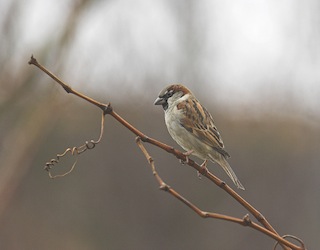 House Sparrows are in decline, but rural areas are less affected than cities. Look out for this gregarious bird in noisy flocks.
House Sparrows are in decline, but rural areas are less affected than cities. Look out for this gregarious bird in noisy flocks.
Photo: © Natural England/Allan Drewitt
Scientific name: Passer domesticus
Other common names: Spadger
Cornish name: Golvan tre
Conservation status: UK Birds of Conservation Concern, Red; IUCN Red List, Least Concern.
What to look for:
- Colouring and appearance: Sturdy build and stout bill. Both sexes have a brown back with black streaks. The male has a black bib, grey and chestnut head and black stripe from bill to eye, and white patches on the neck. There is a white bar on the wings. The female is duller, with undersides a brownish to grey-white colour.
- Size: Wingspan 24 cm; length 14 cm; weight 34 g.
- Where: Most places, close to human habitation, less common in uplands.
- Call: Chirps during courtship and an argumentative ‘cher’ call
- Similar species: Tree Sparrow (which is smaller than the House Sparrow and with a chestnut-coloured rather than grey crown to its head)
 Gangs of noisy House Sparrows, whirring from ground to bush, dust-bathing in the summer in bare earth, or bickering and pecking for food in large flocks, should be one of our most familiar sights, whether in town or country. This small bird has adapted to human proximity with flying colours, living alongside us since the Stone Age and nesting in colonies close to or in human-built structures. They used to be so numerous that, given their habit of eating grain, they were once hunted and killed until not so long ago.
Gangs of noisy House Sparrows, whirring from ground to bush, dust-bathing in the summer in bare earth, or bickering and pecking for food in large flocks, should be one of our most familiar sights, whether in town or country. This small bird has adapted to human proximity with flying colours, living alongside us since the Stone Age and nesting in colonies close to or in human-built structures. They used to be so numerous that, given their habit of eating grain, they were once hunted and killed until not so long ago.
So why have population numbers decreased so severely, by more than 60%, since the mid-1970s? This decline is a well-known wildlife issue, and various theories have been proposed. Two factors that have been highlighted by research as having a strong impact are, firstly, reducing numbers of insects (which the nestlings eat), as our wilder green spaces diminish; and, secondly, fewer nest sites being available, as modern developments do not provide suitable crevices or the old-style eaves that sparrows prefer. There are regional variations in the decline, with the east of England being the worst-hit area (90% decline since 1970). Larger cities have also seen larger declines than rural areas, villages and towns: the House Sparrow has almost disappeared from central London.
Adult House Sparrows eat grain and seeds, but feed their young on insects in the untidy-looking nest. They nest in colonies, and each pair mates several times during the breeding season. They usually produce three broods each year, and sometimes more, in clutches of four to five eggs on average. Despite pairing with one partner, both sexes do mate with other individuals. House Sparrows are quite bold: they are known to turn other species out of their nests, the site of which they will then take over, and aggressively defend their nest.
Did you know…?
…House Sparrows mate frequently and breed very rapidly: this led to the old belief that their eggs could be used as an aphrodisiac. They were also associated with Aphrodite, Goddess of Love, by the ancient Greeks.
…There are twelve sub-species of House Sparrow across its European and Asian range. Our UK subspecies is Passer domesticus domesticus.
…The loud ‘whirr’ of a house Sparrow’s wings is caused by their rapid wingbeats (about 15 per second).
More information and references:
Svensson, L., Mullarney, K., Zetterstrom, D.,1986. Collins Bird Guide, second edition (translated by Christie, D., Svensson, L.). HarperCollins, London.
Published: August 2014
Author: Amanda Scott
Photos: Top, © Natural England/Allan Drewitt; below, Amanda Scott

